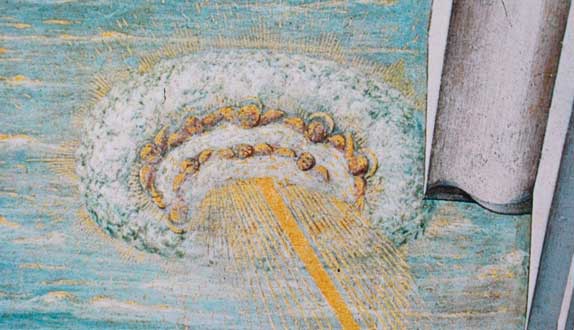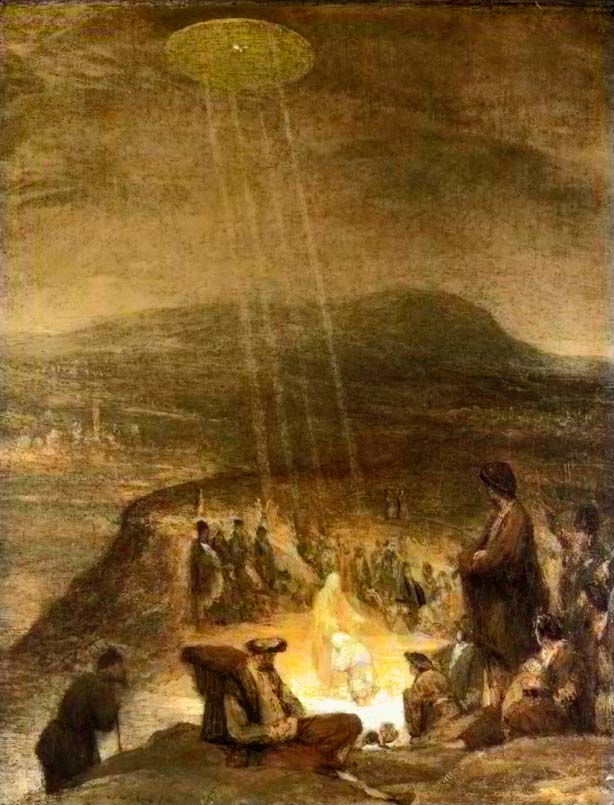It looks like you're using an Ad Blocker.
Please white-list or disable AboveTopSecret.com in your ad-blocking tool.
Thank you.
Some features of ATS will be disabled while you continue to use an ad-blocker.
share:
Not only are there strange "aerial objects" and "beings" depicted in ancient cave drawings around the world, there are also strange objects to be
found in famous Renaissance artwork. Some sceptics say that these "aerial objects" are the artists way of interpreting cosmic objects, like stars
or comets. Some say that these objects could also represent divine beings, like angels.
Prior to the Renaissance Period, art was commissioned by the Catholic Church, which gave artists strict guidelines on what to paint. The art from that time, was decorative and two-dimensional, because artists didn't depict people or the world very realistically. However, at the turn of the 14th century, that soon changed, as Renaissance artists started utilizing new techniques, like perspective, shadows and started painting realistic objects and people.
A good example of this can be seen in Giotto di Bondone's, "The Lamentation," which is displayed at Scrovegni Chapel in Padua, Italy. Done in 1305, it shows this new realism, seen in his realistic portrayal of human anatomy and emotion.
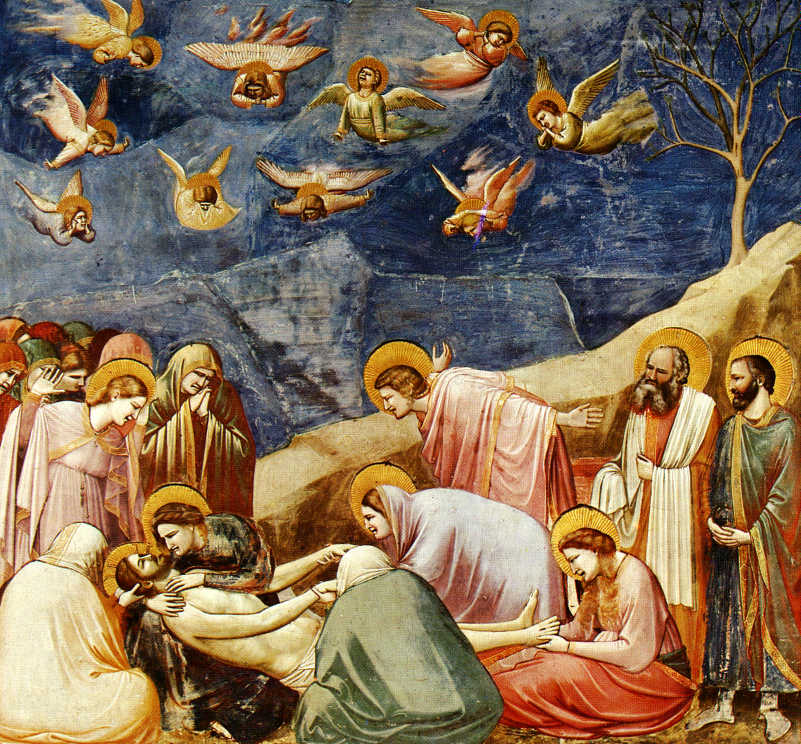
If artists from the Renaissance Period were focusing on accurate, realistic paintings of objects and people, how can we explain the strange objects seen in the following Renaissance works of art?
The "Tenture de la Vie de la Vierge" (1330), Unknown Artist. This artwork is located at the French Basilica Notre-Dame in Beaune, Burgundy. Notice the saucer shape object in the background?
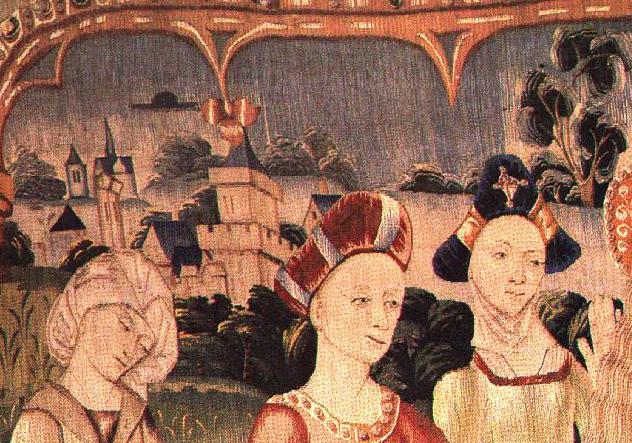

Painting from the French book," Le Livre Des Bonnes Moeurs" (1338), by Jacques Legrand. Sphere in the painting resembles a hot-air baloon, but there were no balloons in 14th century France.
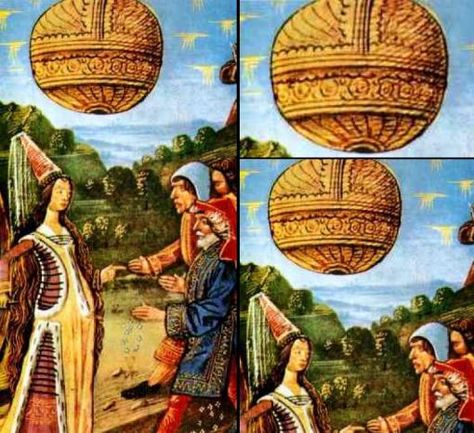
The Crucifixion Of Christ (1350), which hangs above the Visoki Decani Monastery in Kosovo. This painting shows realistic angels and people, as well as "spacecraft" with pilots in them.


The Miracle Of The Snow (1428-1432), by Masolino da Panicale. This painting commemorates the foundation of the Santa Maria Maggiore in the center of Rome. Was the artist trying to depict aerial anomolies that were seen back in 352 AD?
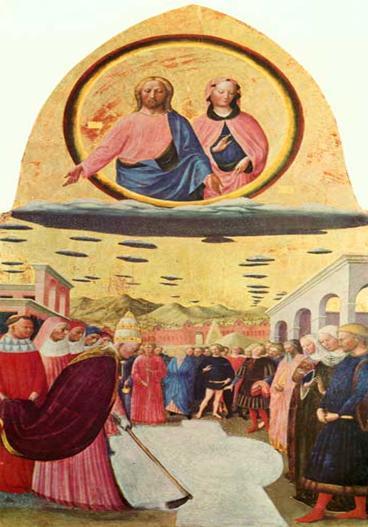
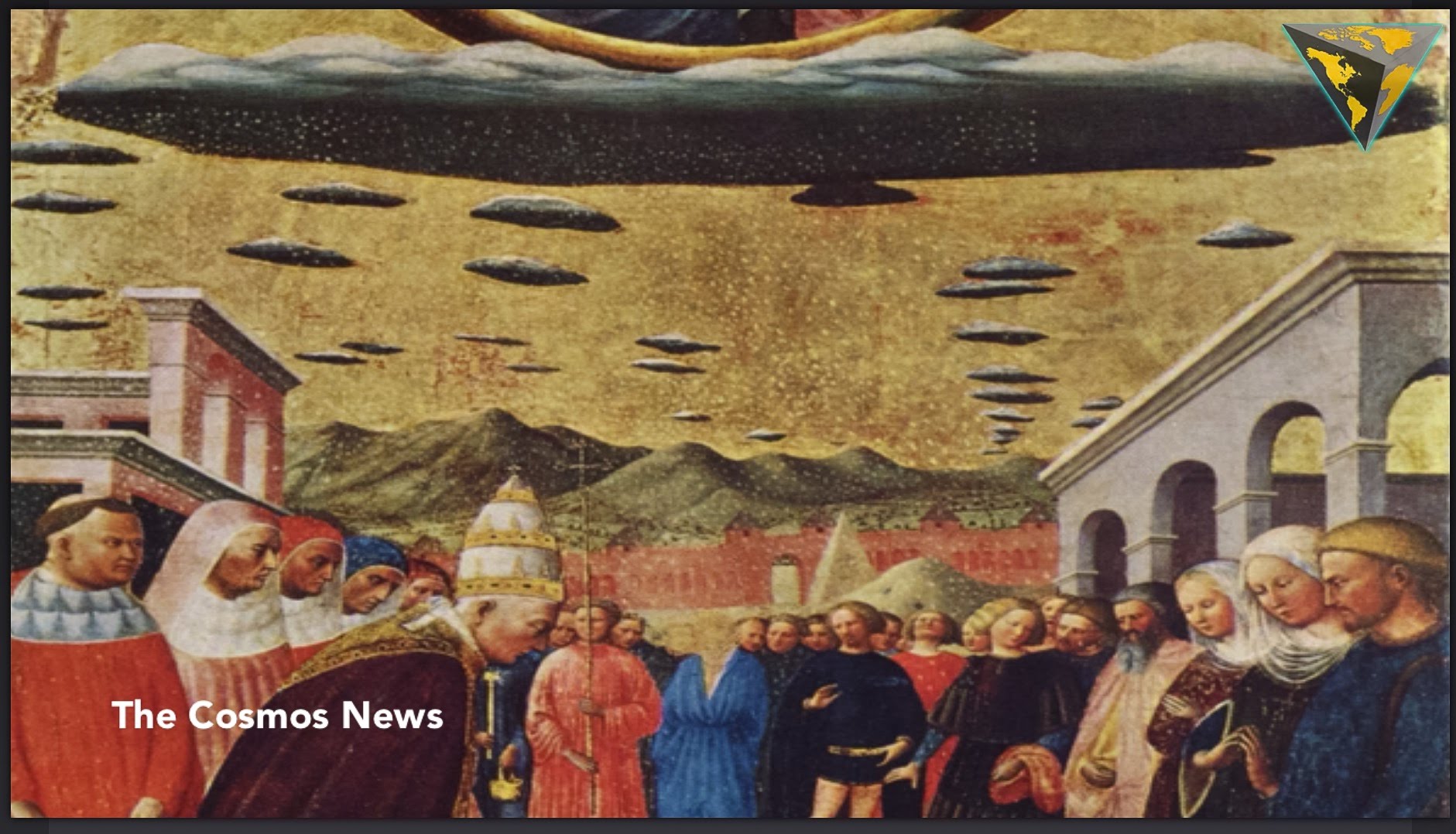
iconsandimagery.blogspot.com...
The Annunciation With Saint Emidus (1486), by Carlo Crivelli. This work shows the Virgin Mary learning she will be giving birth to Jesus Christ. Why not draw a "realistic" angel? This circular cloud shows a beam of light, like a laser, emitted from beneath it.
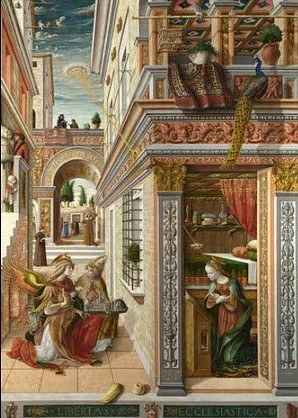
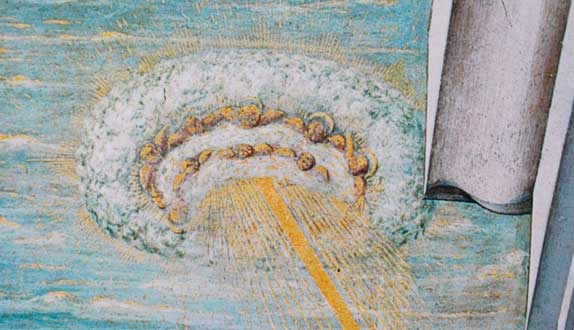
The Madonna With Saint Giovannino (late 1400s), most likely painted by Domenico Ghirlandaio. This painting shows a man, in the background, looking up at an oval, aerial object. Artists from this time period were drawing realistic angels and celestial objects, so is this a realistic painting depicting a UFO?

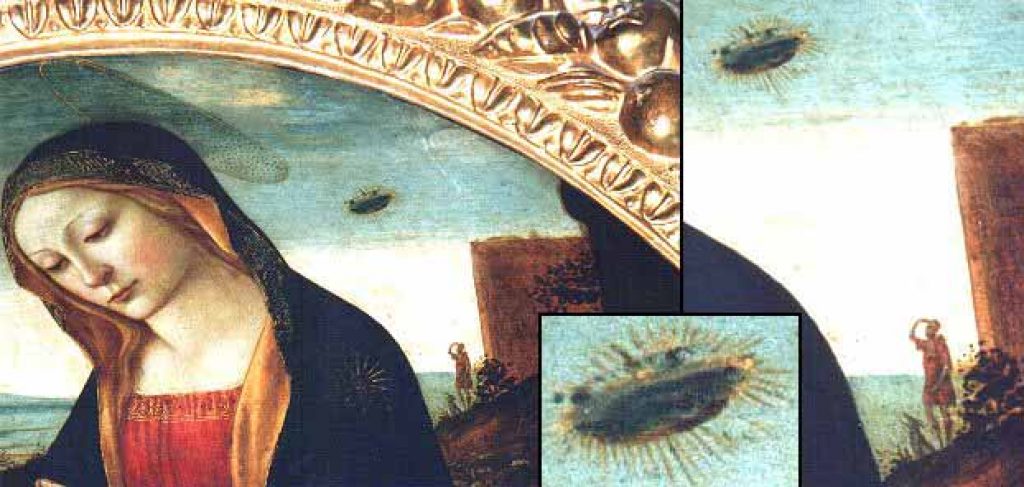
A 17th century fresco from the Svetishoveli Cathedral in Mtskheta, Georgia. The two saucer shaped objects on either side of Christ contain faces, which can be seen in the detail image.
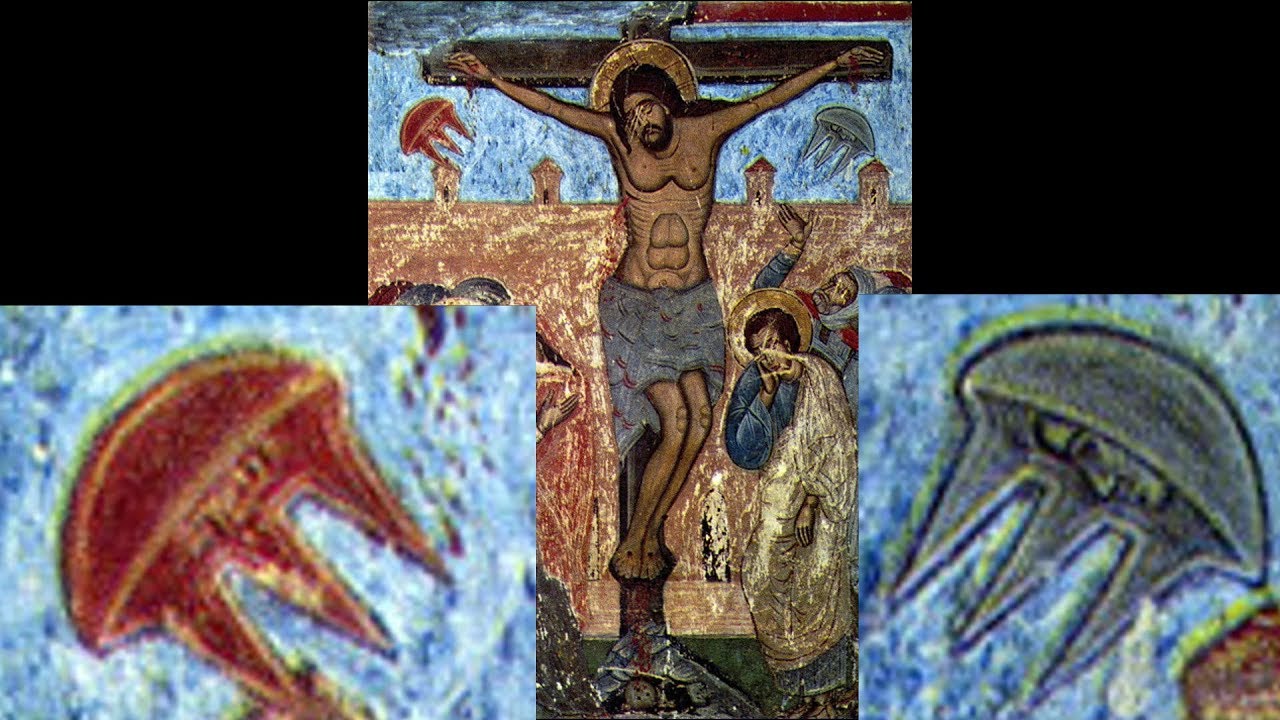
The “Israel, Put Your Hope In The Lord” Painting (circa 1600s), Residing now in the Church of the Dominican Monastery in Sighisoara, Romania. What exactly is that object above the building, shown in this painting?
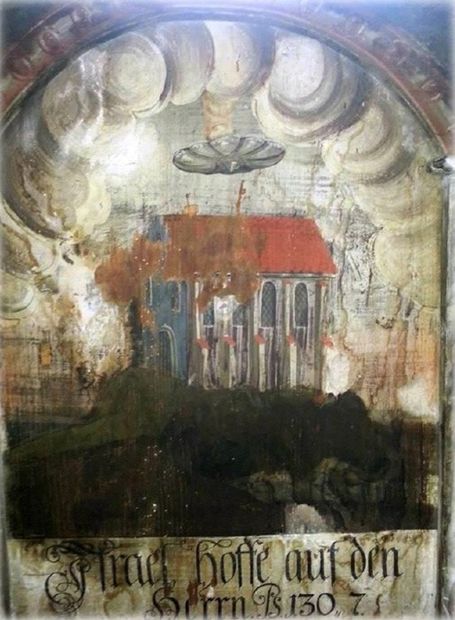
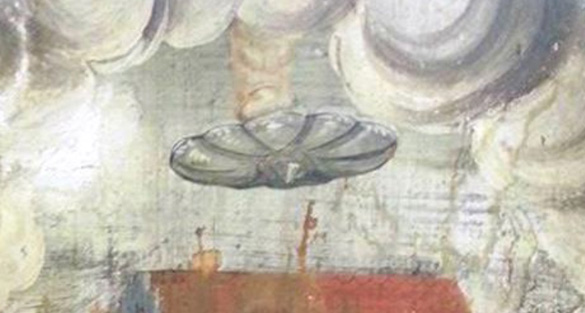
www.romania-insider.com...
This painting was done right after the Renaissance Period, in the early 18th century. The Baptism Of Christ (1710), by Aert de Gelde. This painting clearly shows four beams of light, being emitted by a circular, aerial object.
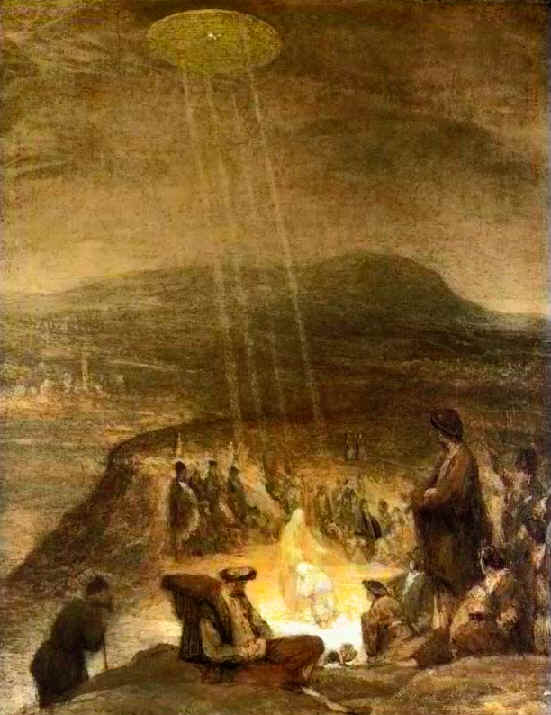
Prior to the Renaissance Period, art was commissioned by the Catholic Church, which gave artists strict guidelines on what to paint. The art from that time, was decorative and two-dimensional, because artists didn't depict people or the world very realistically. However, at the turn of the 14th century, that soon changed, as Renaissance artists started utilizing new techniques, like perspective, shadows and started painting realistic objects and people.
A good example of this can be seen in Giotto di Bondone's, "The Lamentation," which is displayed at Scrovegni Chapel in Padua, Italy. Done in 1305, it shows this new realism, seen in his realistic portrayal of human anatomy and emotion.

If artists from the Renaissance Period were focusing on accurate, realistic paintings of objects and people, how can we explain the strange objects seen in the following Renaissance works of art?
The "Tenture de la Vie de la Vierge" (1330), Unknown Artist. This artwork is located at the French Basilica Notre-Dame in Beaune, Burgundy. Notice the saucer shape object in the background?


Painting from the French book," Le Livre Des Bonnes Moeurs" (1338), by Jacques Legrand. Sphere in the painting resembles a hot-air baloon, but there were no balloons in 14th century France.

The Crucifixion Of Christ (1350), which hangs above the Visoki Decani Monastery in Kosovo. This painting shows realistic angels and people, as well as "spacecraft" with pilots in them.


The Miracle Of The Snow (1428-1432), by Masolino da Panicale. This painting commemorates the foundation of the Santa Maria Maggiore in the center of Rome. Was the artist trying to depict aerial anomolies that were seen back in 352 AD?


Legend says that between the 4th and the 5th of August of 352, Pope Liberius and Giovanni, a rich Roman gentleman, dreamed of Mother Mary asking them to build a church devoted to her on the Esquilino hill, one of the famous Seven Hills of Rome. The virgin also told them that at the place chosen to build the church it was going to snow. Generally, snow is extremely rare in Rome, even in the coldest seasons, so the following morning when a rectangle of snow was discovered on the Esquilino hill during the hottest month of the Roman Summer, it was regarded as miraculous. People crowded to see the patch of snow, which persisted despite the heat. As soon as the plot for the building had been staked out, the snow melted, and the first major church in Rome in honor of Mary was erected in it’s place.
There has been some speculation among “UFOlogists” that this event was actually a phenomenon of extraterrestrial origin. In fact, this “Miracle of the Snow” is likened to another event that occurred at 2.30 pm, 27 October 1954: several discs were reported flying in the sky over Florence, and left in their strange passage "flakes", white and “cotton-like”. The substance was quick to disintegrate if held in the hand. Nearly sixty years later the case on the Florence phenomenon remains unresolved. Speculation links these two events, and there are those who maintain that this is why Masolino’s clouds are not depicted like normal clouds, lacking any vaporous contours, but are all clearly delineated, almost disc-like in their appearance.
iconsandimagery.blogspot.com...
The Annunciation With Saint Emidus (1486), by Carlo Crivelli. This work shows the Virgin Mary learning she will be giving birth to Jesus Christ. Why not draw a "realistic" angel? This circular cloud shows a beam of light, like a laser, emitted from beneath it.


The Madonna With Saint Giovannino (late 1400s), most likely painted by Domenico Ghirlandaio. This painting shows a man, in the background, looking up at an oval, aerial object. Artists from this time period were drawing realistic angels and celestial objects, so is this a realistic painting depicting a UFO?


A 17th century fresco from the Svetishoveli Cathedral in Mtskheta, Georgia. The two saucer shaped objects on either side of Christ contain faces, which can be seen in the detail image.

The “Israel, Put Your Hope In The Lord” Painting (circa 1600s), Residing now in the Church of the Dominican Monastery in Sighisoara, Romania. What exactly is that object above the building, shown in this painting?


Tourists visiting an old church in the Romanian medieval town of Sighisoara will be surprised to see something that resembles an UFO painted on one of the walls. The strange painting appears on one of the walls of the 13th century Monastery Church (Biserica Manastirii) located inside the Medieval Citadel in Sighisoara, Transylvania region.
The church, built in the 13th century, burned down in the 17th century and was then rebuilt. That is when a series of new paintings appeared in the church, including the one that depicts the strange object that looks like an UFO.
www.romania-insider.com...
This painting was done right after the Renaissance Period, in the early 18th century. The Baptism Of Christ (1710), by Aert de Gelde. This painting clearly shows four beams of light, being emitted by a circular, aerial object.

I've seen cloud formations like The Miracle Of The Snow (1428-1432), by Masolino da Panicale. I was flying in a flight from Stansted to Edinburgh in
an early January evening. We were coming in to land and after crossing downwards through the upper cloud layer sheet, we could see the sunset in the
distance and another cloud sheet below. In between were these dark disc shaped clouds just hanging in there at all heights. Perhaps in time lapse they
would look like a lava lamp. Being dark almost black indicates a large water droplet size.
In that painting, you can see that many are lined up with the cloud peaks, so they are being blown by the wind towards the observer. They are generally known as Altocumulus lenticularis clouds, and would indicate that a storm is brewing.
In that painting, you can see that many are lined up with the cloud peaks, so they are being blown by the wind towards the observer. They are generally known as Altocumulus lenticularis clouds, and would indicate that a storm is brewing.
If one thinks that weird or odd, the Wings on Angels and Djinn that can fly are almost drawn like a Swastika...partially any ways.



What this means, no idea...peace...Nazis on the moon
...a dradel... who know, but they are all drawn like it.



What this means, no idea...peace...Nazis on the moon
...a dradel... who know, but they are all drawn like it.
Those strange pods that were in Jesus's crucification pictures must have been something they figured hauled the souls away to heaven. I have seen
other similar craft like that in other old pictures of art. I wonder where that shape idea came from? I don't think an alien craft that shape and
size would be feasible. Now, an advanced earth civilization having the technology might be just something like a flying car for the people running
them. Who knows.
I am sure that we are not being told about ancient advanced technology if they have found anything, someday when we are ready, someone will reinvent it and make a lot of money of their patent. If I found an ancient advanced craft in a cave, do you think I would tell our government about it, they would haul it off and tell me to shut up or they will destroy my life. I would just tinker with it and try to get it working.
I am sure that we are not being told about ancient advanced technology if they have found anything, someday when we are ready, someone will reinvent it and make a lot of money of their patent. If I found an ancient advanced craft in a cave, do you think I would tell our government about it, they would haul it off and tell me to shut up or they will destroy my life. I would just tinker with it and try to get it working.
a reply to: shawmanfromny
The hidden code in Da Vinci's Mona Lisa, painted sometime between 1503 and 1519 was likely prior art for this painting.
The Baptism Of Christ (1710), by Aert de Gelde
The hidden code in Da Vinci's Mona Lisa, painted sometime between 1503 and 1519 was likely prior art for this painting.
Some one want to tell us, that we are not alone, but where are they, what a mistery
If artists from the Renaissance Period were focusing on accurate, realistic paintings of objects and people, how can we explain the strange objects seen in the following Renaissance works of art?
Ever heard of religious symbolism?
Seriously guys, how about researching the historical context first, instead of making crap up about aliens and lasers?
Or just read the previous ATS threads explaining these images. For example:
originally posted by: moebius
Ever heard of religious symbolism?
Seriously guys, how about researching the historical context first, instead of making crap up about aliens and lasers?
originally posted by: shawmanfromny
The Annunciation With Saint Emidus (1486), by Carlo Crivelli. This work shows the Virgin Mary learning she will be giving birth to Jesus Christ. Why not draw a "realistic" angel? This circular cloud shows a beam of light, like a laser, emitted from beneath it.
www.abovetopsecret.com...
originally posted by: Cicada
Next we'll deal with image 1 and 1b of the above post, Carlo Crivelli's "Annunciation". The reasons why some would feel this image depicts UFO contact is obvious but once again most of this confusion lies in poor, blurry reproductions. It is in no way uncommon for Annunciation scenes to feature a ray of light descending from the sky to contact the Madonna. What appears here to be a flying saucer is in fact an illuminated cloud within which are two rings of golden angels. This is quite clear in better reproductions:
This painting was done right after the Renaissance Period, in the early 18th century. The Baptism Of Christ (1710), by Aert de Gelde. This painting clearly shows four beams of light, being emitted by a circular, aerial object.
Essentially the same can be said of the Aert DeGelder's (a rather obscure artist) "Baptism of Christ". The image as provided in the above post is extremely poor. In a better version the circular field in the sky is obviously occupied by a white dove, a standard symbol of the Holy Spirit. As an aspect of the Holy Trinity it is wholly normal that it is depicted within a luminous circle. Representing divine entities with radiant disks or halos is common in iconography of many cultures and religions. A clearer image again makes this easy to see:
etcetera, quite a few images are explained in that thread in a more appropriate context.
originally posted by: shawmanfromny
If artists from the Renaissance Period were focusing on accurate, realistic paintings of objects and people, how can we explain the strange objects seen in the following Renaissance works of art?
That's a huge leap in reasoning there. Do you believe the sky was littered with winged people and everyone had glowing heads then?


These are both depictions of the sun and moon. They were anthropomorphised in the past - a leftover from paganism.

This is a shield protecting the church. Shields are an archetype for defense, and one in the sky represents divine protection. It was actually a very common motif as you can see on coins
Above the city two hands coming from clouds hold a round shield with the Hebrew signature JEHOVAH
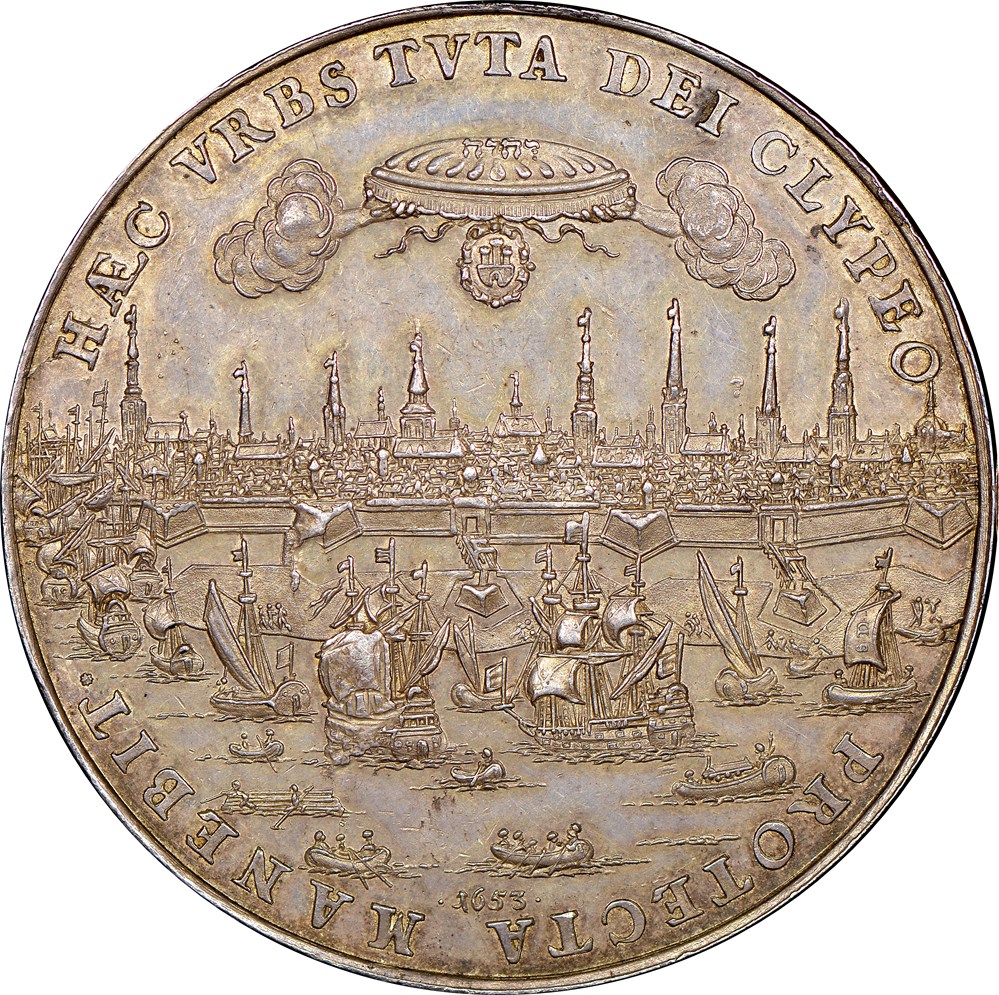
And then you've got glowing clouds enlightening people, representing divine inspiration... it makes sense if you understand religious symbolism and psychology.
You can see from the content that these artists didn't use much imagination in their craft, no overboard symbolism or abstract embellishment a la
your usual religious iconography, They weren't having fun or practicing, they were recording. And judging by the more subtle approaches to some of
these UFO pictures, they weren't very popular conversation topic in the rennaisance period either. And yet, clearly some people thought it was
important to mention them in some way, to keep track of when and how these objects showed up.
Julius Caesar, Mark Twain and the 39 members of the Heaven's Gate Away Team were all abducted by aliens and went away with a comet. Good thread that
adds some continuity for UFO science. Still lots of unsolved UFO cases, for example the first 13 letters of the CIA Kryptos puzzle could not have been
decrypted in 1990 since even the other three parts weren't officially cracked until 1997 so perhaps this will turn out to be an example of alien time
travel?


edit on 26-2-2018 by Cauliflower because: (no reason given)
a reply to: shawmanfromny
I dig it..
I made a TOP 20 youtube video about the same topic..
Check it out here OP
I dig it..
I made a TOP 20 youtube video about the same topic..
Check it out here OP
a reply to: Ridhya
Marduk or Anzu?


Religious symbolism, astrological daily race of sun trying to ram the moon? The sun's/son truimph over the devil maybe?
Marduk or Anzu?


Religious symbolism, astrological daily race of sun trying to ram the moon? The sun's/son truimph over the devil maybe?
edit on 26-2-2018 by Specimen because: (no reason given)
edit on 26-2-2018 by Specimen because: (no reason
given)
edit on 26-2-2018 by Specimen because: (no reason given)
I live very close to the border of illinois..and cross the river every month.. When we get closer to crossing the river there are signs depicting
barges in the water..one time while looking at them I thought of some of these paintings. I think some of them with crafts/ufos in the lower third of
the pics might be boats in the water..the view of the painting is from above a lake/river/ocean/sea..so it could be they are showing the water and
boat and not the horizon..
the others..no clue..weird to say the least but look at Hieronymus Bosch..
the others..no clue..weird to say the least but look at Hieronymus Bosch..
edit on 26-2-2018 by Neopan100 because: (no reason given)
a reply to: shawmanfromny
Although techniques changed, most paintings were still commissioned by the Church or by rich people, so the religious symbolisms still applied, and that's what we can see in those paintings.
Art history explains it, but most people don't like art or history, and even less when joined and linked to religion, but when discussing religious paintings we need to follow the same rules they used, otherwise is like talking about Aliens and UFOs with someone that was never interested in them, they may have their opinions but are not based on real data.
Although techniques changed, most paintings were still commissioned by the Church or by rich people, so the religious symbolisms still applied, and that's what we can see in those paintings.
Art history explains it, but most people don't like art or history, and even less when joined and linked to religion, but when discussing religious paintings we need to follow the same rules they used, otherwise is like talking about Aliens and UFOs with someone that was never interested in them, they may have their opinions but are not based on real data.
originally posted by: ArMaP
Art history explains it, but most people don't like art or history, and even less when joined and linked to religion, but when discussing religious paintings we need to follow the same rules they used, otherwise is like talking about Aliens and UFOs with someone that was never interested in them, they may have their opinions but are not based on real data.
Same thing with literature. It wasn't until recently that people even bothered to think that when they write a story about something it should be as "accurate" and truthful as possible. Mostly what historians and authors did was plagiarize wholesale from other authors, and what they didn't know they just made up to be entertaining. There was no division between "fiction" and "non-fiction."
a reply to: Blue Shift
There was usually enough math embodied in the art works to support the fiction.
For example there were several interpretations concerning the "Holy Lance" which apparently lost its point in popular legend during the Byzantine era.
In 615, Jerusalem and its relics were captured by the Persian forces of King Khosrau II (Chosroes II). According to the Chronicon Paschale, the point of the lance, which had been broken off, was given in the same year to Nicetas, who took it to Constantinople and deposited it in the church of Hagia Sophia, and later to the Church of the Virgin of the Pharos.
People do a lot of crazy things in the depths of religious passion, who really knows what happened to the ear of Van Gogh in 1888?
There was usually enough math embodied in the art works to support the fiction.
For example there were several interpretations concerning the "Holy Lance" which apparently lost its point in popular legend during the Byzantine era.
In 615, Jerusalem and its relics were captured by the Persian forces of King Khosrau II (Chosroes II). According to the Chronicon Paschale, the point of the lance, which had been broken off, was given in the same year to Nicetas, who took it to Constantinople and deposited it in the church of Hagia Sophia, and later to the Church of the Virgin of the Pharos.
People do a lot of crazy things in the depths of religious passion, who really knows what happened to the ear of Van Gogh in 1888?
originally posted by: TzarChasm
You can see from the content that these artists didn't use much imagination in their craft, no overboard symbolism or abstract embellishment a la your usual religious iconography, They weren't having fun or practicing, they were recording. And judging by the more subtle approaches to some of these UFO pictures, they weren't very popular conversation topic in the rennaisance period either. And yet, clearly some people thought it was important to mention them in some way, to keep track of when and how these objects showed up.
Can you enlighten us further as to what were the "very popular conversation topic(s) in the rennaisance period?"
And do provide links and citations.
Harte
a reply to: Blue Shift
One problem with paintings like these is that many people think the artists acted on their own, but things weren't like that.
It was only after the Renaissance (I don't remember the name for that period, what I know about art I learned mostly from helping my sister doing her school work, she is the artist of the family) that the rich class started to be big and rich enough to spend money in things like art, starting a market for art painted without any other reason besides the will of the artist. Before and during the Renaissance artists worked when they were commissioned to do some work, and those works were very expensive, so they were only commissioned by the big powers, mostly the church and big, powerful families. The work was very expensive not only because one painting like that takes months to make but also because they had to make their own paint, and, sometimes, the lack of consistency in the pigments makes it difficult to create the right colours. The options were also limited, as oil painting only became popular in the 15th century, but even then, the time it took for the oil paint to dry (around 3 weeks) made it a slow and expensive job.
It's not a coincidence that all those paintings are related to religion, and it's not a coincidence either that on non-religious paintings we don't see things like those "UFOs".
One problem with paintings like these is that many people think the artists acted on their own, but things weren't like that.
It was only after the Renaissance (I don't remember the name for that period, what I know about art I learned mostly from helping my sister doing her school work, she is the artist of the family) that the rich class started to be big and rich enough to spend money in things like art, starting a market for art painted without any other reason besides the will of the artist. Before and during the Renaissance artists worked when they were commissioned to do some work, and those works were very expensive, so they were only commissioned by the big powers, mostly the church and big, powerful families. The work was very expensive not only because one painting like that takes months to make but also because they had to make their own paint, and, sometimes, the lack of consistency in the pigments makes it difficult to create the right colours. The options were also limited, as oil painting only became popular in the 15th century, but even then, the time it took for the oil paint to dry (around 3 weeks) made it a slow and expensive job.
It's not a coincidence that all those paintings are related to religion, and it's not a coincidence either that on non-religious paintings we don't see things like those "UFOs".
a reply to: ArMaP
Queen Elizabeth probably commissioned William Shakespeare to write The Merry Wives of Windsor.
So there is evidence that there was secular control of the arts as well.
In 1553 Queen Mary restored Roman Catholicism as the state religion, and the Pope became head of the church once again.
Queen Elizabeth probably commissioned William Shakespeare to write The Merry Wives of Windsor.
So there is evidence that there was secular control of the arts as well.
In 1553 Queen Mary restored Roman Catholicism as the state religion, and the Pope became head of the church once again.
new topics
-
University student disciplined after saying veganism is wrong and gender fluidity is stupid
Education and Media: 46 minutes ago -
Geddy Lee in Conversation with Alex Lifeson - My Effin’ Life
People: 1 hours ago -
God lived as a Devil Dog.
Short Stories: 2 hours ago -
Police clash with St George’s Day protesters at central London rally
Social Issues and Civil Unrest: 3 hours ago -
TLDR post about ATS and why I love it and hope we all stay together somewhere
General Chit Chat: 4 hours ago -
Hate makes for strange bedfellows
US Political Madness: 6 hours ago -
Who guards the guards
US Political Madness: 9 hours ago -
Has Tesla manipulated data logs to cover up auto pilot crash?
Automotive Discussion: 11 hours ago
top topics
-
Hate makes for strange bedfellows
US Political Madness: 6 hours ago, 14 flags -
Who guards the guards
US Political Madness: 9 hours ago, 13 flags -
whistleblower Captain Bill Uhouse on the Kingman UFO recovery
Aliens and UFOs: 16 hours ago, 11 flags -
Police clash with St George’s Day protesters at central London rally
Social Issues and Civil Unrest: 3 hours ago, 7 flags -
TLDR post about ATS and why I love it and hope we all stay together somewhere
General Chit Chat: 4 hours ago, 5 flags -
University student disciplined after saying veganism is wrong and gender fluidity is stupid
Education and Media: 46 minutes ago, 3 flags -
Has Tesla manipulated data logs to cover up auto pilot crash?
Automotive Discussion: 11 hours ago, 2 flags -
God lived as a Devil Dog.
Short Stories: 2 hours ago, 2 flags -
Geddy Lee in Conversation with Alex Lifeson - My Effin’ Life
People: 1 hours ago, 2 flags
active topics
-
Thousands Of Young Ukrainian Men Trying To Flee The Country To Avoid Conscription And The War
Other Current Events • 119 • : FlyersFan -
Europe declares war on Russia?
World War Three • 65 • : Freeborn -
Candidate TRUMP Now Has Crazy Judge JUAN MERCHAN After Him - The Stormy Daniels Hush-Money Case.
Political Conspiracies • 731 • : Threadbarer -
"We're All Hamas" Heard at Columbia University Protests
Social Issues and Civil Unrest • 248 • : FlyersFan -
University student disciplined after saying veganism is wrong and gender fluidity is stupid
Education and Media • 4 • : chiefsmom -
Police clash with St George’s Day protesters at central London rally
Social Issues and Civil Unrest • 34 • : Freeborn -
-@TH3WH17ERABB17- -Q- ---TIME TO SHOW THE WORLD--- -Part- --44--
Dissecting Disinformation • 626 • : cherokeetroy -
The Superstition of Full Moons Filling Hospitals Turns Out To Be True!
Medical Issues & Conspiracies • 19 • : FloridaManMatty -
Iranian Regime Escalates Hiijab Mandate Through Sexual Violence and Beatings of Women
Mainstream News • 166 • : purplemer -
They Killed Dr. Who for Good
Rant • 67 • : grey580

